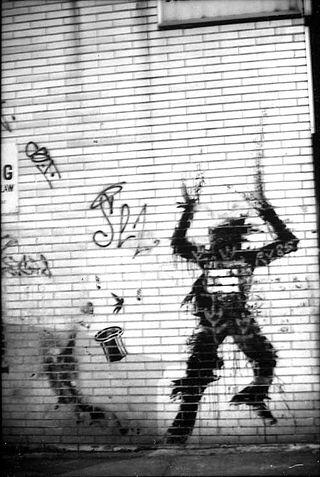
Jean-Michel Basquiat was an American artist who rose to success during the 1980s as part of the Neo-expressionism movement.

Keith Allen Haring was an American artist whose pop art emerged from the New York City graffiti subculture of the 1980s. His animated imagery has "become a widely recognized visual language". Much of his work includes sexual allusions that turned into social activism by using the images to advocate for safe sex and AIDS awareness. In addition to solo gallery exhibitions, he participated in renowned national and international group shows such as documenta in Kassel, the Whitney Biennial in New York, the São Paulo Biennial, and the Venice Biennale. The Whitney Museum held a retrospective of his art in 1997.
Maripol is an artist, film producer, fashion designer and stylist. She has had an influence on the looks of influential artists such as Madonna and Grace Jones. As part of the 1980s New York downtown scene, she captured the likes of Jean-Michel Basquiat, Keith Haring, Andy Warhol, and Debbie Harry with her Polaroid camera. Maripol also produced films, most notably Downtown 81.
Edo Bertoglio is a Swiss photographer, film director and screenwriter. He is the director of Downtown 81 and Face Addict.

Tseng Kwong Chi, known as Joseph Tseng prior to his professional career, was a Hong Kong-born American photographer who was active in the East Village art scene in the 1980s. He is the brother of dancer/choreographer Muna Tseng.
SAMO is a graffiti tag originally used on the streets of New York City from 1978 to 1980. The tag, written with a copyright symbol as "SAMO©", and pronounced Same-Oh, is primarily associated with the artist Jean-Michel Basquiat, but was originally developed as a collaboration between Basquiat and Al Diaz.

Richard Art Hambleton was a Canadian artist known for his work as a street artist. He was a surviving member of a group that emerged from the New York City art scene during the booming art market of the 1980s which also included Keith Haring and Jean-Michel Basquiat. While often associated with graffiti art, Hambleton considered himself a conceptual artist who made both public art and gallery works.

Louis Carreon is a contemporary artist with a background in street art. He frequently exhibits in galleries around the world. One of his best known commissions was a custom mural on a 12-seater private jet for Art Basel Miami, featuring his "International Symbols of Travel." Currently, he is based in Los Angeles and works from his Hollywood studio called The Drip Factory.

Untitled (Gem Spa) is a 1982 painting created by American artist Jean-Michel Basquiat in 1982. It is an autobiographical work depicting a sparsely rendered figure atop a bicycle "drowned in darkness."

The Death of MichaelStewart, known as Defacement, is a painting created by American artist Jean-Michel Basquiat in 1983. The artwork is Basquiat's response to anti-Black racism and police brutality. It memorializes the death of Michael Stewart at the hands of New York City Transit Police for allegedly writing graffiti in the subway. No graffiti was found, according to Stewart's girlfriend at the time of his death.

A Panel of Experts is a painting created by American artist Jean-Michel Basquiat in 1982. The artwork in part is Basquiat's depiction of a catfight between two of his lovers, Suzanne Mallouk and singer Madonna.
The Fun Gallery was an art gallery founded by Patti Astor and Bill Stelling in 1981. The Fun Gallery had a cultural impact until it closed in 1985. As the first art gallery in Manhattan's East Village, it exposed New York to the talents of street art by showcasing graffiti artists like Fab 5 Freddy, Futura 2000, Lee Quiñones, Zephyr, Dondi, Lady Pink, and ERO. Contemporary artists Kenny Scharf, Jean-Michel Basquiat, and Keith Haring also had solo exhibitions at the Fun Gallery.

Irony of Negro Policeman is a painting created by American artist Jean-Michel Basquiat in 1981. It depicts a black figure as police officer.
Annina Nosei is an Italian-born art dealer and gallerist. Nosei is best known for being Jean-Michel Basquiat’s first art dealer and providing him with studio space in the basement of her gallery. From 1981 to 2006, the Annina Nosei Gallery represented or exhibited work by artists such as Barbara Kruger, Robert Longo, Ghada Amer, and Shirin Neshat.
Suzanne Mallouk is a Canadian-born painter, psychiatrist, and psychoanalyst, based in New York City. She is best known for her role within a core of East Village creatives in the 1980s and for her relationship with artist Jean-Michel Basquiat, much of which her friend Jennifer Clement chronicled in Widow Basquiat: A Memoir. In 2015, Vogue magazine listed Basquiat and Mallouk among "The 21 Most Stylish Art World Couples of All Time."

Crown Hotel (Mona Lisa Black Background) is a 1982 painting created by American artist Jean-Michel Basquiat in 1982. The artwork cites Leonardo da Vinci's Mona Lisa and Édouard Manet's Olympia, two canonical works of western art. In June 2013, it sold for $7.4 million at Sotheby’s.

Taxi, 45th/Broadway is a painting created by American artists Jean-Michel Basquiat and Andy Warhol circa 1984–85. The artwork sold at Sotheby's for $9.4 million in November 2018.

Charles the First is a painting created by American artist Jean-Michel Basquiat in 1982. The artwork is a tribute to jazz musician Charlie Parker, and it was the basis for rapper Jay-Z's 2010 song "Most Kingz."

Andy Mouse is a series of silkscreen prints created by American artist Keith Haring in 1986. The character Andy Mouse is a fusion between Disney's Mickey Mouse and Andy Warhol. The series consists of four silkscreen prints on wove paper, released in an edition of 30 per colorway, all signed and dated in pencil by Haring and Warhol.

Untitled (One Eyed Man or Xerox Face) is a painting created by American artist Jean-Michel Basquiat in 1982. In May 2021, it sold for $30.2 million at Christie's in Hong Kong.














